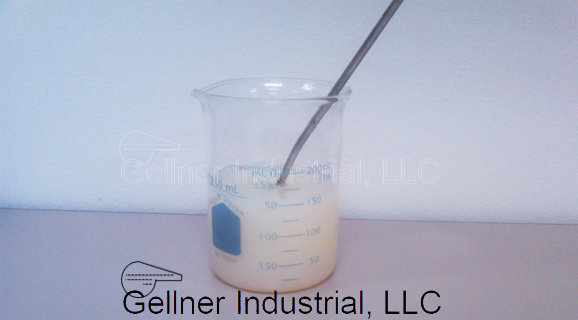Anionic and Cationic Water Based Emulsions

Emulsion polymers that are manufactured by Gellner Industrial are Anionic and Cationic. An emulsion can be Anionic, Cationic, and Non-Ionic. An Anionic emulsion has a negative charge, a Cationic emulsion has a positive charge, and a Non-ionic emulsion has no charge. Most of the things in the world are Anionic and that is why the majority of Research and Development, formulating, and lab testing has been done in the Industrial Coatings Industry to make coatings from Anionic systems.
When an Anionic emulsion is mixed with a Cationic emulsion a strong bond develops and the result is the changing of the substance to a solid. This result is not ideal to be used as a coating because it cannot be applied to substrates. When you apply a Cationic emulsion to an Anionic substrate there is usually better adhesion. Therefore, a Cationic emulsion tends to have better adhesion properties than an Anionic emulsion because of the positive charge.
Anionic emulsion is alkali soluble so therefore susceptible to dissolving by high pH or alkaline detergents. Cationic emulsion will not dissolve that easily in alkaline solutions or alkaline detergents. Anionic emulsions will have very good resistance to acids. Cationic emulsions will readily dissolve in acid solutions once the film is dry.
Emulsion polymers usually dry faster and in certain cases this is not ideal. An example is in gravure printing where a cylinder is rolled through ink to print onto the intended substrate. The company that is using the ink doesn’t want to have the ink dry up quickly on the cylinder. In this case an ink chemist may choose to add a calculated amount of a solution to the Cationic Emulsion to increase the open time and create better flow for printability. With that added solution the emulsion will provide the print with excellent resistance properties, but sometimes adding a solution can reduce resistance properties and separate other chemicals from the emulsion.
Anionic Emulsion Polymers provide paint, inks, and coatings with exceptional adhesion to surfaces like vinyl, plastic, PVC, mylar, polystyrene, and non-porous substrates that require a hard film. Cationic Emulsion Polymers give industrial coatings products alkali resistance, scrub resistance, block resistance, scuff resistance, improved flow, leveling, and open time.
A Cationic emulsion presents more of a challenge to get it to work with additives. The reason is because some of those chemicals added may be Anionic. This will result in the emulsion turning into a solid. So most of the time there are chemicals that are non-ionic that possess no charge that are used as additives to formulate and manufacture coatings.
Water Based Anionic Emulsion Polymers |
Water Based Cationic Emulsion Polymers |
| Ottopol S-30 | Ottopol K-12 |
| Ottopol S-50 | Ottopol K-23 |
| Ottopol S-75 | Ottopol K-65 |
| Ottopol S-100 | Ottopol K-66 |
| Ottopol SX-30 | Ottopol KX-99 |
| Ottopol SX-50 | |
| Ottopol SX-75 | |
| Ottopol SX-100 |